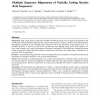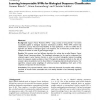758 search results - page 4 / 152 » Coding Exon Detection Using Comparative Sequences |
GCB
2003
Springer
14 years 3 months ago
2003
Springer
Clustering of EST data is a method for the non-redundant representation of an organisms transcriptome. During clustering of large amounts of EST data, usually some large clusters ...
BMCBI
2005
13 years 9 months ago
2005
Background: High quality sequence alignments of RNA and DNA sequences are an important prerequisite for the comparative analysis of genomic sequence data. Nucleic acid sequences, ...
RECOMB
2005
Springer
14 years 10 months ago
2005
Springer
Background: Support Vector Machines (SVMs) ? using a variety of string kernels ? have been successfully applied to biological sequence classification problems. While SVMs achieve ...
BMCBI
2010
13 years 10 months ago
2010
Background: The protein-coding regions (coding exons) of a DNA sequence exhibit a triplet periodicity (TP) due to fact that coding exons contain a series of three nucleotide codon...
BMCBI
2005
13 years 9 months ago
2005
Background: NemaFootPrinter (Nematode Transcription Factor Scan Through Philogenetic Footprinting) is a web-based software for interactive identification of conserved, non-exonic ...



